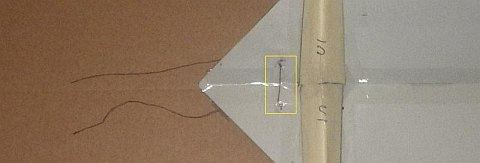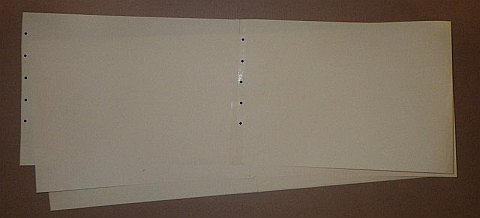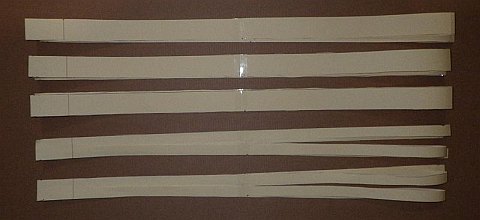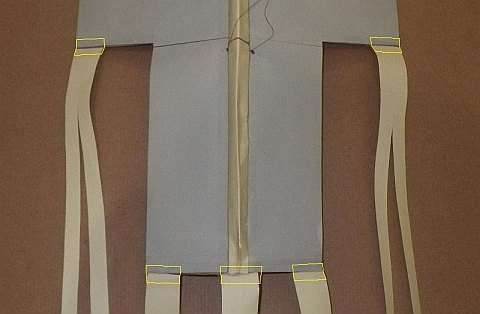- Home Page
- Paper Kites
- ... Sode Kite
How to Make a Paper Sode Kite
Step by Step—Page 3 of 3
The MBK Paper Sode
Upper Horizontal Spar Attachment
Bear in mind that most of the steps below are more
easily done on a tabletop with the vertical spar up
against one edge of the tabletop. That's to keep the bit you are
working on flat!
Tape One Edge
 One edge taped
One edge taped- Take an upper spar piece, and align it with the sail leading edge as shown. The layering of paper should be out of sight on the underside. One corner of the wider end should be touching the centerline of the kite sail, also as shown in the photo.
- Place lengths of sticking tape as shown in the photo.
- Fold the overhanging tape around as shown in the next photo.
 Tape overhangs folded around
Tape overhangs folded around
Tape Other Edge
 Edge tacked at centerline end
Edge tacked at centerline end- Go to the centerline of the sail, and pull the free edge of the spar piece back toward the taped edge so the lower guide line becomes visible.
- Tack the edge down with a short strip of tape as indicated in the photo. As before, the corner should be where the centerline and the guide line cross.
 Edge taped all along
Edge taped all along- Tack down more and more of the spar, making sure the edge lines up with the lower guide line. Go all the way across to the corner of the sail as shown in the photo. The tape strips can overlap a little, but don't leave any gaps.
Shape Spar Piece
 Pinching started at one end
Pinching started at one end- Go to one end of the spar piece, and carefully pinch it between finger and thumb as in the photo. Just like the vertical spar, the aim is to get a crease right in the middle.
 V shape formed all the way along
V shape formed all the way along- Work your way along the spar piece, pinching tightly all the way. I like to use both hands at once, close together.
- Go all the way along and then back again so nothing is missed. See the photo.
 Both upper horizontal spar pieces in place and shaped
Both upper horizontal spar pieces in place and shaped- Now tape the other upper horizontal spar piece in place—just like you did for the first one.
- Shape the spar piece by pinching as you did for the first one. There they both are, in the photo.
Lower Horizontal Spar Attachment
This is very similar to the upper horizontal spar attachment.
Tape One Edge
 One edge taped
One edge taped- Take a spar piece, and align it with the sail trailing edge as shown. The layering of paper should be out of sight on the underside. One corner of the wider end should be touching the centerline of the kite sail, also as shown in the photo.
- Place and fold around lengths of sticking tape as shown in the photo.
Complete Spar Attachment and Shaping
 Both lower spars taped and shaped
Both lower spars taped and shaped- As done for the upper spar pieces, tape down the remaining edges to the guide lines.
- Shape the spar pieces by pinching, keeping the crease right in the middle as you go along.
Bottom Horizontal Spar Attachment
This is similar to the previous spar pieces.
Tape One Edge
 One edge taped
One edge taped- Take one of the remaining spar pieces, and align it with the sail centerline and a guide line as in the photo.
- Tape in place. Any overhanging tape can be folded around or snipped off with scissors.
Tape to Sail Trailing Edge
 Other edge taped—to sail trailing edge
Other edge taped—to sail trailing edge- Stick a length of tape to the spar piece, leaving half the tape width hanging free.
- Carefully line up the spar piece and the edge of the sail before folding the tape around onto the underside of the sail. Take your time; it's tricky!
Complete Spar Attachment and Shaping
 Both bottom spar pieces taped and shaped
Both bottom spar pieces taped and shaped- In the same way, attach the other spar piece.
- Shape both spar pieces to a V shape by pinching along their lengths.
Connect Spar Pieces
 Upper spar pieces connected with three pieces of tape
Upper spar pieces connected with three pieces of tape- By folding the sail along the centerline, butt the upper two horizontal spar pieces together in the middle.
- Tack the join together with a square of sticking tape over the top. If the edges don't match well on your first attempt, take the tape off and try again.
- Apply three pieces of sticking tape to the join, starting with the one that goes from top to bottom in the photo. Each piece should be 6 cm (2 1/2 in.) long. The pieces on either side of the spar appear narrow because of the viewing angle.
- In the same way, join the lower and bottom spar pieces together. If your tape is too wide for the bottom piece, try snipping a length to half width before sticking.
Like to see a video clip? Just scroll down to near the end of this page.
 All spars complete
All spars complete
The Bridle Lines
Make Holes
 Where the bridle holes go
Where the bridle holes go- There's no need for measuring here. Just note where the tape is, and make sure the holes just miss the vertical spar!
- Using the sharp corner of a scissor tip, penetrate the paper where the four holes are in the photo. You can open up the holes a little with the point of a pen if you want to.
Attach Upper Line
 Upper line secured with tape
Upper line secured with tape- Measure and snip off a 35 cm (14 in.) length of polyester thread.
- Put the thread through the two holes nearest the nose of the kite. Make the length of thread equal from each hole.
- Hold the thread in place with a short strip of tape as indicated in the photo.
Attach Lower Line
 Lower line secured with tape
Lower line secured with tape- Measure and snip off a 60 cm (24 in.) length of polyester thread.
- As before, put the thread through the two holes, and make the length equal from each hole.
- Hold the thread in place with a short strip of tape as indicated in the photo.
Adjust Bridle Lines
 Bridle lines adjusted
Bridle lines adjusted- Bring all four pieces of thread together between finger and thumb.
- Suspend the bridle while the kite lays flat on its back with as little thread as possible coming out the top of your hand. See the photo.
- Adjust so the bridle lines come together just past the lower edge of the upper horizontal spar. That is, when you are looking from directly above.
- Double check that all lines have pulled straight before tying a Multi-Strand Double knot close to where you gripped them all.
- Trim the free ends to the same length with scissors. See below:
 A closer look at the bridle knot after excess thread trimmed
A closer look at the bridle knot after excess thread trimmed
The Tails
One Sheet to Start
 Five dots at 3 cm (1 1/4 in.) intervals from top paper edge
Five dots at 3 cm (1 1/4 in.) intervals from top paper edge- Mark five dots on a sheet of paper as shown at top left. From the top edge of the paper, all spacings are 3 cm (1 1/4 in.).
Note: To avoid lots of measuring, just use this sheet as a template for the sheets that follow! Line up the sheets, and just copy or trace the dots each time.
Add More Sheets
 Another sheet similarly marked with dots and taped on
Another sheet similarly marked with dots and taped on- Take another sheet of paper, and mark with dots, exactly like the first one.
- Bring the two sheets of paper together, short edge to short edge.
- Lay tape all the way across the join, and trim flush with the paper's edge with scissors.
- Flip the paper, and lay tape across the join again, trimming as before.
- Flip the paper again so the dots are on top.
 More sheets dotted and taped until there are 10 sheets
More sheets dotted and taped until there are 10 sheets- Repeat the process, marking dots and taping both sides of the join, until you have 10 sheets of paper joined.
- On the last sheet, add dots across both short edges.
Note: A kite made from A4 paper will have slightly longer tails than a kite made from Letter-sized paper. However, the difference in flying characteristics between the two kites out in the field would be hard to spot!
Cut Into Tails
 Lines ruled through all the dots
Lines ruled through all the dots- With ruler and pen, connect all the dots along the paper from end to end.
- Rule a line across the paper, 5 cm (2 in.) from one short edge. See this near the left side of the photo.
 Three main tails and two side tails
Three main tails and two side tails- With scissors, cut along the five lines to create five ribbons that are 10 sheets of paper long.
- Cut two of the ribbons down to six sheets in length, and keep the four-sheet offcuts as spare tail material!
- Cut the two shorter ribbons in half, right up the middle, until you reach the line that goes across the paper. This can be done by eye. There they are at the bottom of the photo.
Attach to Sail
 Tails taped to rear side of sail
Tails taped to rear side of sail- Lay the sail down with the vertical spar against the tabletop or floor.
- Align the five tails with the sail edges and spars by referring to the photo. Tack each tail in place with just a tiny piece of tape.
- When happy with the placement, use a strip of sticky tape all the way across each tail—as indicated in the photo.
 Tail taped on front side of sail
Tail taped on front side of sail- Flip the kite over.
- Cut away the corner of the vertical spar at the tail end of the sail. This will allow the spar paper sides to collapse flat against the sail when you stick tape over it.
- Apply five strips of sticking tape as indicated in the photo.
- That's it. You're done!
Flying!
 Nothing to it—attach line, catch breeze
Nothing to it—attach line, catch breezeAfter taking the kite to a flying field or beach, your flying line can be tied behind the large knot of the bridle lines, wrapped around all the lines. That's it, you're ready to fly.
Avoid flying in very windy weather. The thread should be good to around 30 kph, but there are no guarantees beyond that.
If the kite seems very reluctant to climb despite plenty of breeze, you might need to retie the bridle, shifting the knot a centimeter or two (1/2 to 1 in.) toward the nose end.
A note about durability: After about 2 ½ hours of flying time, my sode started to develop small tears in the three main tails—right near the ends. That's nothing a few strips of sticky tape won't fix, though. Then the kite is good for a few more hours in the air.
I hope you enjoyed learning how to make the MBK Paper Sode design!
As mentioned earlier, there's more kite making on this site than you can poke a stick at. :-)
Want to know the most convenient way of using it all?
The Big MBK E-book Bundle is a collection of downloads—printable PDF files which provide step-by-step instructions for many kites large and small.
That's every kite in every MBK series.
